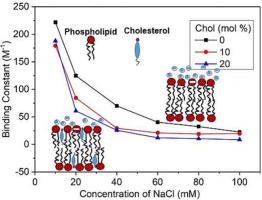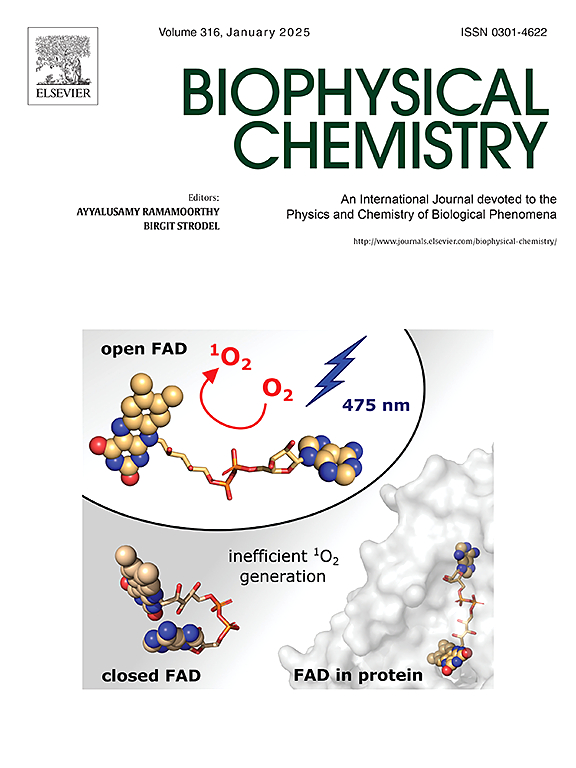Cholesterol modulates the interaction of sodium salt with negatively charged phospholipid membrane
IF 2.2
3区 生物学
Q2 BIOCHEMISTRY & MOLECULAR BIOLOGY
引用次数: 0
Abstract
We present a systematic study on how alkali metal salts, like NaCl and NaI, affect negatively charged phospholipid vesicles using a range of experimental methods. Our goal was to find out how chain saturation and cholesterol affect the interaction between the ions and the membrane. An isothermal titration calorimetry study on large unilamellar vesicles made from dimyristoyl phosphatidylcholine (DMPC) revealed that Na+ shows higher binding affinity to the gel phase at 15 °C compared to the fluid phase at 30 °C. Further, cations also show stronger affinity to the membrane in the fluid composed of saturated lipids than that of unsaturated lipids. The binding affinity of Na + with anionic vesicles prepared from a mixture of DMPC and DMPG was found to decrease significantly with increasing cholesterol as well as salt concentrations, as revealed by the zeta potential study. Besides the binding constant, the Gouy Chapman theory based on the electrostatic double layer shows that cholesterol reduces the surface charge density without altering the significant area per molecule. Further, the effect of counterions was investigated using fluorescence spectroscopy of an environment-sensitive lipophilic dye, nile red. Although cholesterol alters the emission properties of nile red significantly, there is no significant change in the presence of ions. This result suggests that anions do not bind significantly to anionic vesicles. The main striking feature of the ion-membrane interaction in the presence of cholesterol is that membranes with saturated lipids exhibit a completely opposite trend from membranes with unsaturated lipids.

胆固醇可调节钠盐与带负电的磷脂膜之间的相互作用。
我们采用一系列实验方法,对碱金属盐(如 NaCl 和 NaI)如何影响带负电荷的磷脂囊泡进行了系统研究。我们的目标是找出链饱和度和胆固醇如何影响离子与膜之间的相互作用。对由二肉豆蔻酰基磷脂酰胆碱(DMPC)制成的大型单拉米尔囊泡进行的等温滴定量热研究显示,与 30 °C 时的液相相比,15 °C 时 Na+ 与凝胶体相的结合亲和力更高。此外,阳离子在由饱和脂质组成的流体中与膜的亲和力也强于不饱和脂质。zeta 电位研究发现,Na + 与由 DMPC 和 DMPG 混合物制备的阴离子囊泡的结合亲和力随着胆固醇和盐浓度的增加而显著降低。除了结合常数外,基于静电双层的 Gouy Chapman 理论表明,胆固醇会降低表面电荷密度,但不会改变每个分子的显著面积。此外,还利用对环境敏感的亲脂性染料尼罗河红的荧光光谱研究了反离子的影响。虽然胆固醇会显著改变尼罗河红的发射特性,但在有离子存在的情况下却没有明显变化。这一结果表明,阴离子与阴离子囊泡的结合并不明显。胆固醇存在时离子与膜相互作用的主要显著特点是,饱和脂质的膜与不饱和脂质的膜表现出完全相反的趋势。
本文章由计算机程序翻译,如有差异,请以英文原文为准。
求助全文
约1分钟内获得全文
求助全文
来源期刊

Biophysical chemistry
生物-生化与分子生物学
CiteScore
6.10
自引率
10.50%
发文量
121
审稿时长
20 days
期刊介绍:
Biophysical Chemistry publishes original work and reviews in the areas of chemistry and physics directly impacting biological phenomena. Quantitative analysis of the properties of biological macromolecules, biologically active molecules, macromolecular assemblies and cell components in terms of kinetics, thermodynamics, spatio-temporal organization, NMR and X-ray structural biology, as well as single-molecule detection represent a major focus of the journal. Theoretical and computational treatments of biomacromolecular systems, macromolecular interactions, regulatory control and systems biology are also of interest to the journal.
 求助内容:
求助内容: 应助结果提醒方式:
应助结果提醒方式:


